
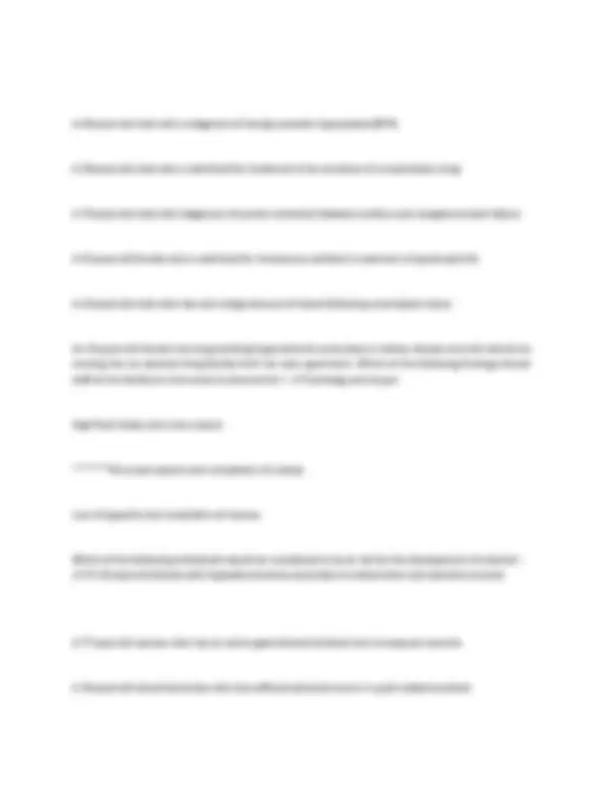
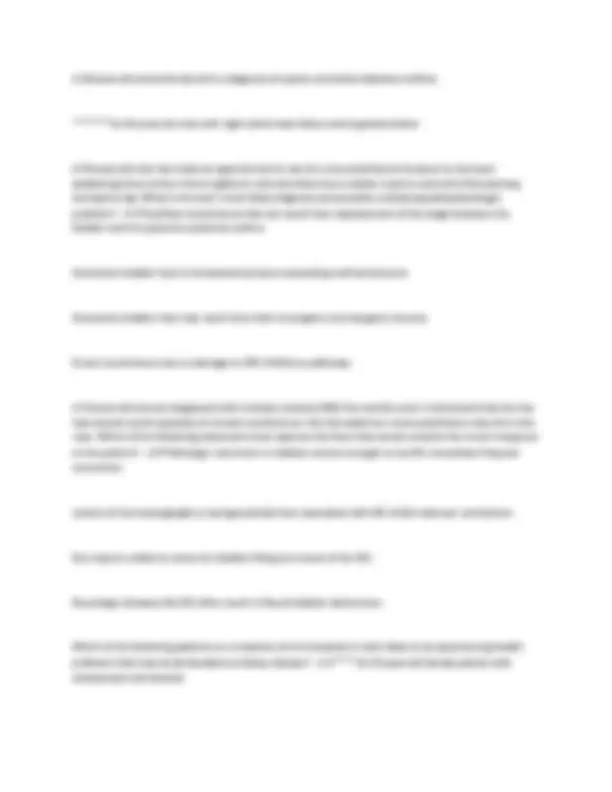
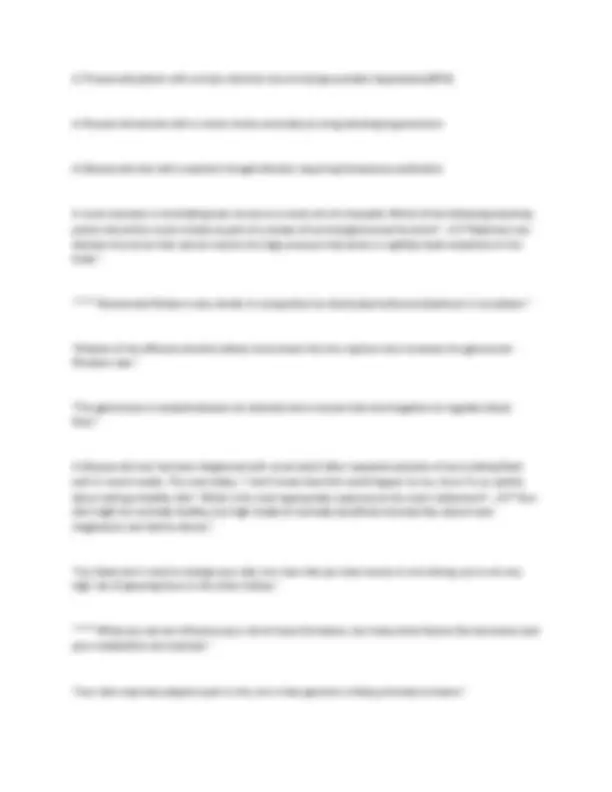
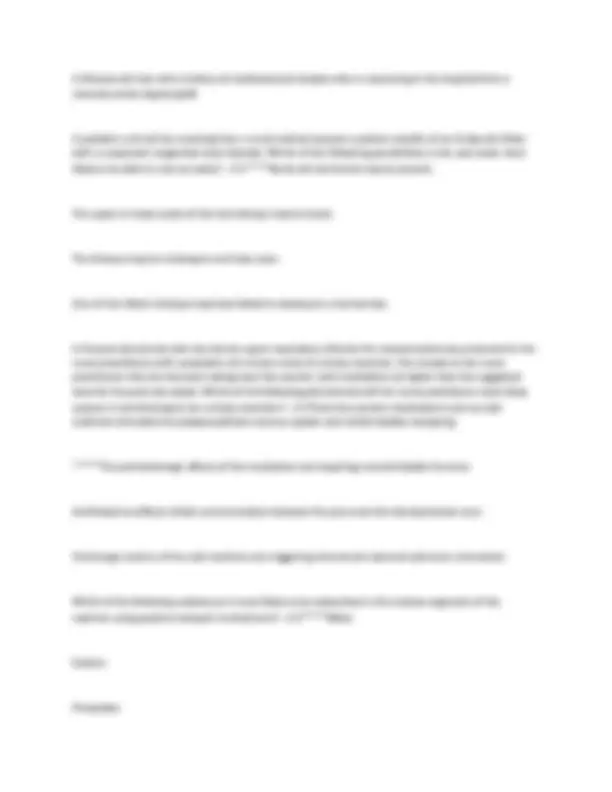
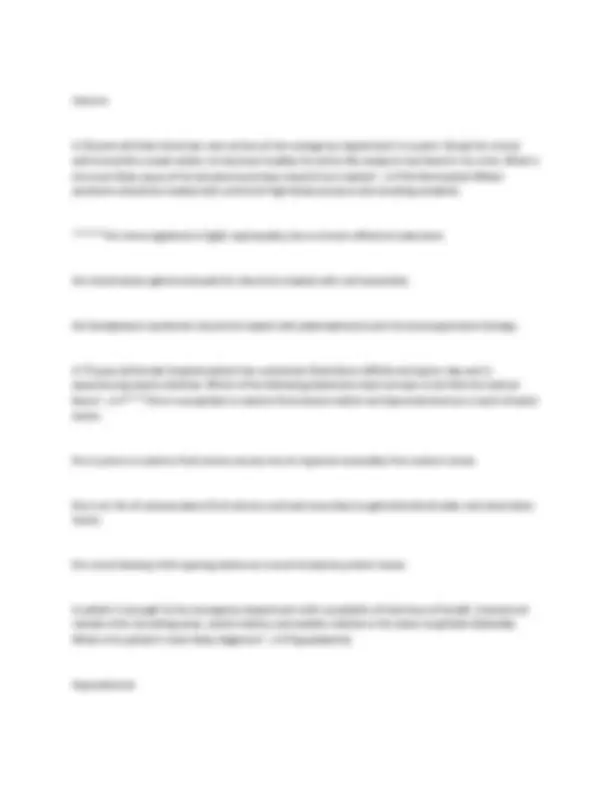
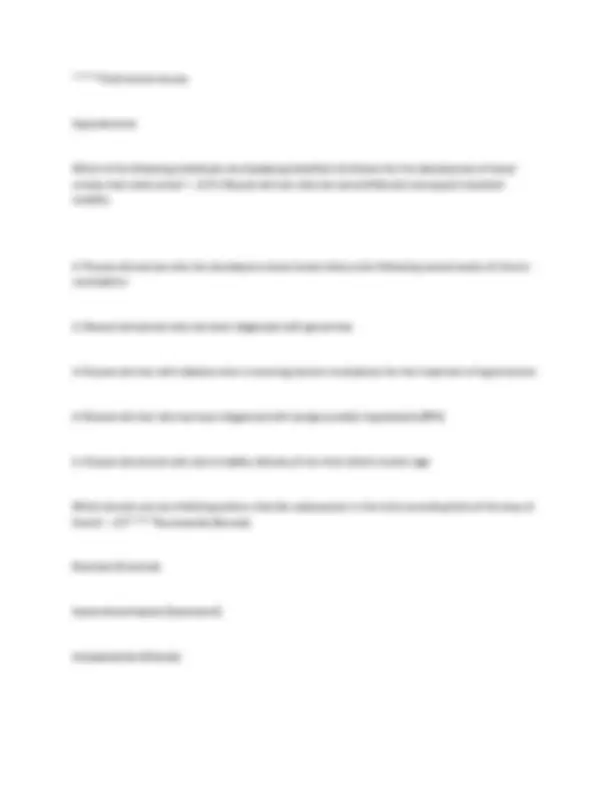


Study with the several resources on Docsity

Earn points by helping other students or get them with a premium plan


Prepare for your exams
Study with the several resources on Docsity

Earn points to download
Earn points by helping other students or get them with a premium plan
Community
Ask the community for help and clear up your study doubts
Discover the best universities in your country according to Docsity users
Free resources
Download our free guides on studying techniques, anxiety management strategies, and thesis advice from Docsity tutors
Specific diseases or conditions: covered in the unit? Key concepts: like inflammation, infection, or tissue repair? Practice questions or exam preparation? Specific case studies: discussed in the unit
Typology: Exams
1 / 11

This page cannot be seen from the preview
Don't miss anything!







A 3 4 - year-old male patient has diagnoses of liver failure, ascites, and hepatic encephalopathy secondary to alcohol abuse. The patient's family is questioning the care team about why his abdomen is so large even though he is undernourished and emaciated. Which of the following statements most accurately underlies the explanation that a member of the care team would provide to the family? - ✔✔An inordinate amount of interstitial fluid is accumulating in the patient's abdomen. The transcellular component of the intracellular fluid compartment contains far more fluid than normal. *********** The normally small transcellular fluid compartment, or third space, is becoming enlarged. Gravity-dependent plasma is accumulating in the patient's peritoneal cavity. A 3 1 - year-old patient with a diagnosis of end-stage liver failure has been admitted to the intensive care unit of a hospital. Arterial blood gas sampling indicates that the man has an acid-base imbalance. Which of the following situations is most likely to result in an inappropriate pH? - ✔✔Renal excretion of HCO 3 - in the presence of excess base Transcompartmental exchange of H+ and potassium ions Low albumin and plasma globulin levels Conservation or formation of new HCO 3 - by the kidneys A 4 - year-old boy who has been deaf since birth and has bilateral cataracts has been brought to the emergency department by his mother because she noticed blood in the toilet after he last voided. Urinalysis confirms heavy microscopic hematuria as well as proteinuria. What will the care team's initial differential diagnosis most likely be? - ✔✔Immunoglobulin A nephropathy Henoch-Schonlein purpura nephritis
Systemic lupus erythematosus glomerulonephritis Alport syndrome An 87 - year-old male resident of an assisted living facility has been consistently continent of urine until the last several weeks. Which of the following actions by the care providers at the facility is the most likely priority? - ✔✔Showing the resident the correct technique for exercises to improve bladder, sphincter, and pelvic floor tone Teaching the resident about protective pads, collection devices, and medications that may be effective Providing patient education focusing on the fact that occasional incontinence is a normal, age-related change **** 8 Performing a physical examination and history to determine the exact cause and character of the incontinence An 82 - year-old resident of a long-term care facility with a recent history of repeated urinary tract infections and restlessness is suspected of having urinary retention. Which of the following actions by the care team is most appropriate? - ✔✔Urinalysis focusing on the presence or absence of microorganisms, blood, or white cells in the man's urine Renal ultrasound aimed at identifying acute or chronic kidney disease Ultrasound bladder scanning to determine the residual volume of urine after voiding Uroflowmetry to determine to rate of the patient's urine flow Which of the following patients would be considered to have a significant risk of developing the prerenal form of acute renal failure? - ✔✔An 80 - year-old female who has been admitted for treatment of dehydration, hyponatremia, and malnutrition
A 6 0 - year-old obese female with a diagnosis of poorly controlled diabetes mellitus *******An 81 - year-old man with right-sided heart failure and hypothyroidism A 5 5 - year-old man has made an appointment to see his nurse practitioner because he has been awakening three to four times nightly to void and often has a sudden need to void with little warning during the day. What is the man's most likely diagnosis and possible underlying pathophysiologic problem? - ✔✔Overflow incontinence that can result from displacement of the angle between the bladder and the posterior proximal urethra Overactive bladder due to intravesical pressure exceeding urethral pressure Overactive bladder that may result from both neurogenic and myogenic sources Stress incontinence due to damage to CNS inhibitory pathways A 5 1 - year-old woman diagnosed with multiple sclerosis (MS) five months prior is distressed that she has had several recent episodes of urinary incontinence. She has asked her nurse practitioner why this is the case. Which of the following statements best captures the facts that would underlie the nurse's response to the patient? - ✔✔Pathologic reductions in bladder volume brought on by MS necessitate frequent micturition. Lesions of the basal ganglia or extrapyramidal tract associated with MS inhibit detrusor contraction. She may be unable to sense her bladder filling as a result of her MS. Neurologic diseases like MS often result in flaccid bladder dysfunction. Which of the following patients on a medical unit of a hospital is most likely to be experiencing health problems that may be attributable to kidney disease? - ✔✔****An 81 - year-old female patient with osteoporosis and anemia
A 7 7 - year-old patient with urinary retention due to benign prostatic hyperplasia (BPH) "Your diet may have played a part in this, but in fact genetics is likely primarily to blame." A 5 5 - year-old woman with a recent stroke secondary to long-standing hypertension A 6 0 - year-old man with a systemic fungal infection requiring intravenous antibiotics A nurse educator is orientating new nurses to a renal unit of a hospital. Which of the following teaching points should the nurse include as part of a review of normal glomerular function? - ✔✔"Nephrons are delicate structures that cannot endure the high pressure that exists in capillary beds elsewhere in the body." ****"Glomerular filtrate is very similar in composition to blood plasma found elsewhere in circulation." "Dilation of the afferent arteriole allows more blood into the nephron and increases the glomerular filtration rate." "The glomerulus is located between an arteriole and a venule that work together to regulate blood flow." A 6 0 - year-old man has been diagnosed with renal calculi after repeated episodes of excruciating flank pain in recent weeks. The man states, "I don't know how this could happen to me, since I'm so careful about eating a healthy diet." What is the most appropriate response to the man's statement? - ✔✔"Your diet might be normally healthy, but high intake of normally beneficial minerals like calcium and magnesium can lead to stones." "You likely don't need to change your diet, but now that you have stones in one kidney, you're at very high risk of growing them in the other kidney." ****"What you eat can influence your risk of stone formation, but many other factors like hormones and your metabolism are involved."
Exchange of Na+ and H+ ions A 6 8 - year-old woman with a new onset of vascular dementia has recently begun retaining urine. Which of the following physiological phenomena would her care providers most realistically expect to be currently occurring as a result of her urinary retention? - ✔✔Overflow incontinence and loss of contraction power Decompensation, bladder stretching, and high residual urine volume Decreased urine production and nitrogenous wasted excretion by the kidneys ****Hypertrophy of the bladder muscle and increased bladder wall thickness A patient with poorly controlled diabetes mellitus presents to the emergency department with suspected ketoacidosis. Which of the following diagnostic results would be most likely to confirm this diagnosis? - ✔✔Decreased CO 2 , decreased anion gap ****Increased CO 2 , increased anion gap, base deficit High ammonia levels, decreased anion gap, high potassium Low O2 levels, increased anion gap, base excess Which of the following individuals is at the highest risk for developing a urinary tract infection (UTI)? - ✔✔****A 30 - year-old obese woman with poorly controlled diabetes mellitus A 3 8 - year-old man with high urine output due to antidiuretic hormone insufficiency A 6 6 - year-old man undergoing dialysis for the treatment of chronic renal failure secondary to hypertension
A 6 0 - year-old man with a history of cardiovascular disease who is recovering in the hospital from a coronary artery bypass graft A pediatric unit will be receiving from a rural medical outpost a patient transfer of an 8 - day-old infant with a suspected congenital renal disorder. Which of the following possibilities is the care team most likely to be able to rule out early? - ✔✔****Renal cell carcinoma may be present. The upper or lower poles of the two kidneys may be fused. The kidneys may be misshapen and have cysts. One of the infant's kidneys may have failed to develop to a normal size. A 6 1 - year-old woman who has had an upper respiratory infection for several weeks has presented to her nurse practitioner with complaints of a recent onset of urinary retention. She reveals to her nurse practitioner that she has been taking over-the-counter cold medications at higher than the suggested dose for the past two weeks. Which of the following phenomena will her nurse practitioner most likely suspect is contributing to her urinary retention? - ✔✔Over-the-counter medications such as cold medicine stimulate the parasympathetic nervous system and inhibit bladder emptying. *****The anticholinergic effects of the medication are impairing normal bladder function. Antihistamine effects inhibit communication between the pons and the thoracolumbar cord. Cholinergic actions of the cold medicine are triggering internal and external sphincter contraction. Which of the following substances is most likely to be reabsorbed in the tubular segments of the nephron using passive transport mechanisms? - ✔✔****Water Sodium Phosphate
*****Fluid volume excess Hyponatremia Which of the following individuals are displaying identified risk factors for the development of lower urinary tract obstruction? - ✔✔A 20 - year-old man who has spina bifida and consequent impaired mobility A 7 4 - year-old woman who has developed a lower bowel obstruction following several weeks of chronic constipation A 3 0 - year-old woman who has been diagnosed with gonorrhea A 5 5 - year-old man with diabetes who is receiving diuretic medications for the treatment of hypertension A 6 8 - year-old man who has been diagnosed with benign prostatic hyperplasia (BPH) A 3 2 - year-old woman who had a healthy delivery of her third child 4 months ago Which diuretic acts by inhibiting sodium chloride reabsorption in the thick ascending limb of the loop of Henle? - ✔✔*****Bumetanide (Bumex) Mannitol (Osmitrol) Hydrochlorothiazide (Hydrodiuril) Acetazolamide (Diamox)
Which of the following data would a clinician consider to be most indicative of acute renal failure? - ✔✔Decreased urine output, hematuria, increased GFR Decreased serum creatinine and blood urea nitrogen (BUN), decreased potassium and calcium levels *****Increased nitrogenous waste levels, decreased glomerular filtration rate (GFR) Alterations in blood pH, peripheral edema A 7 7 - year-old female with a diagnosis of chronic obstructive pulmonary disease is experiencing impaired gas exchange and CO2 retention, despite a rapid respiratory rate. Which of the following phenomena would her care team most realistically anticipate? - ✔✔*****Her kidneys will adapt with an increase in plasma HCO 3 - and her pH will decrease. Her body may be producing excess metabolic CO 2. Her kidneys are likely to reabsorb H+ and secrete HCO 3 -. Arterial blood gas sampling is likely to indicate a pH in the range of 7. 45 to 7. 55. A 1 4 - year-old boy who appears to be intoxicated is brought to the emergency department by ambulance. The EMTs report that the boy has denied consuming anything out of the ordinary, but an open antifreeze container was found in the boy's room. Which of the following is likely to be used to treat the patient's symptoms? - ✔✔Sodium bicarbonate *****Fomepizole Syrup of ipecac Gastric lavage